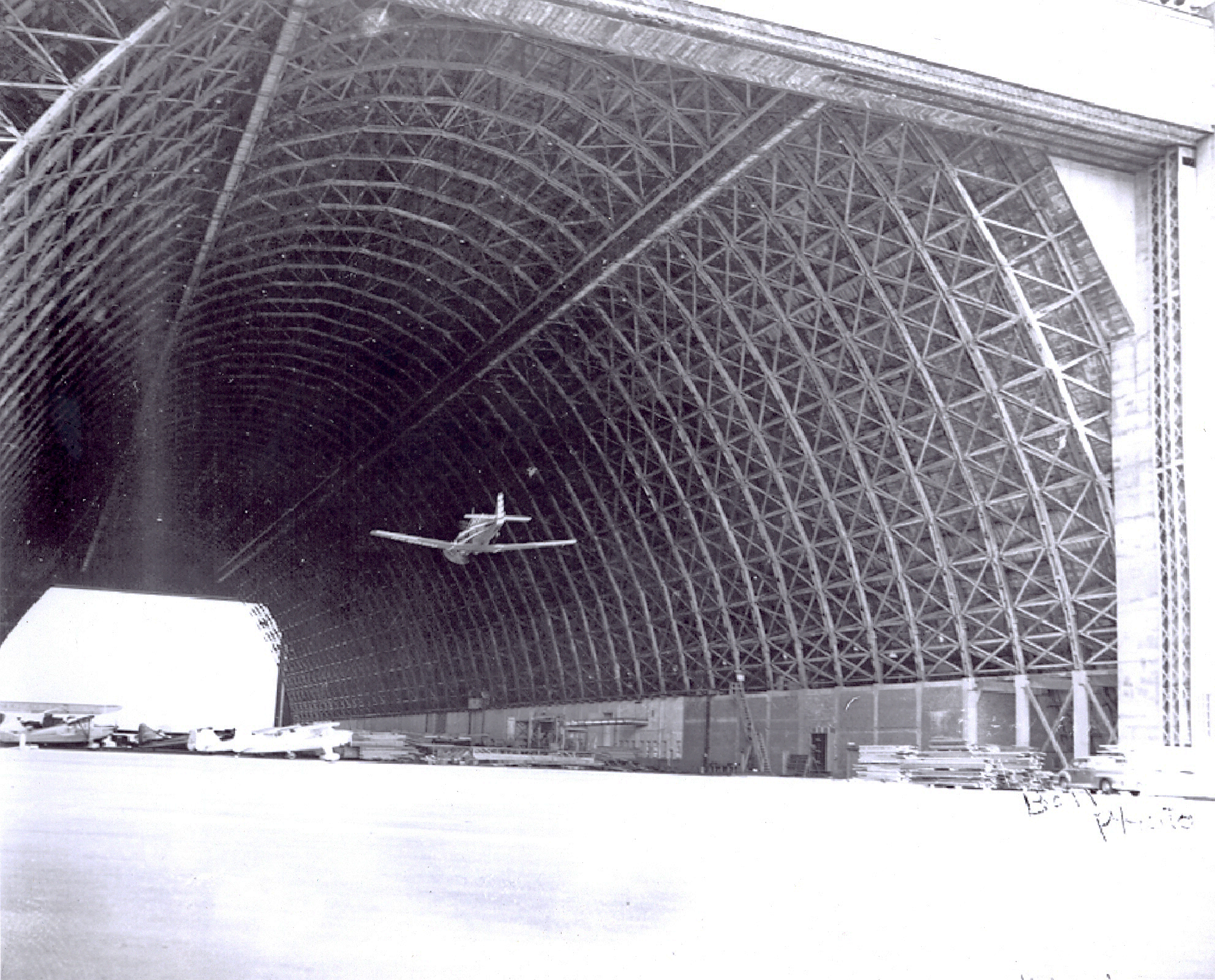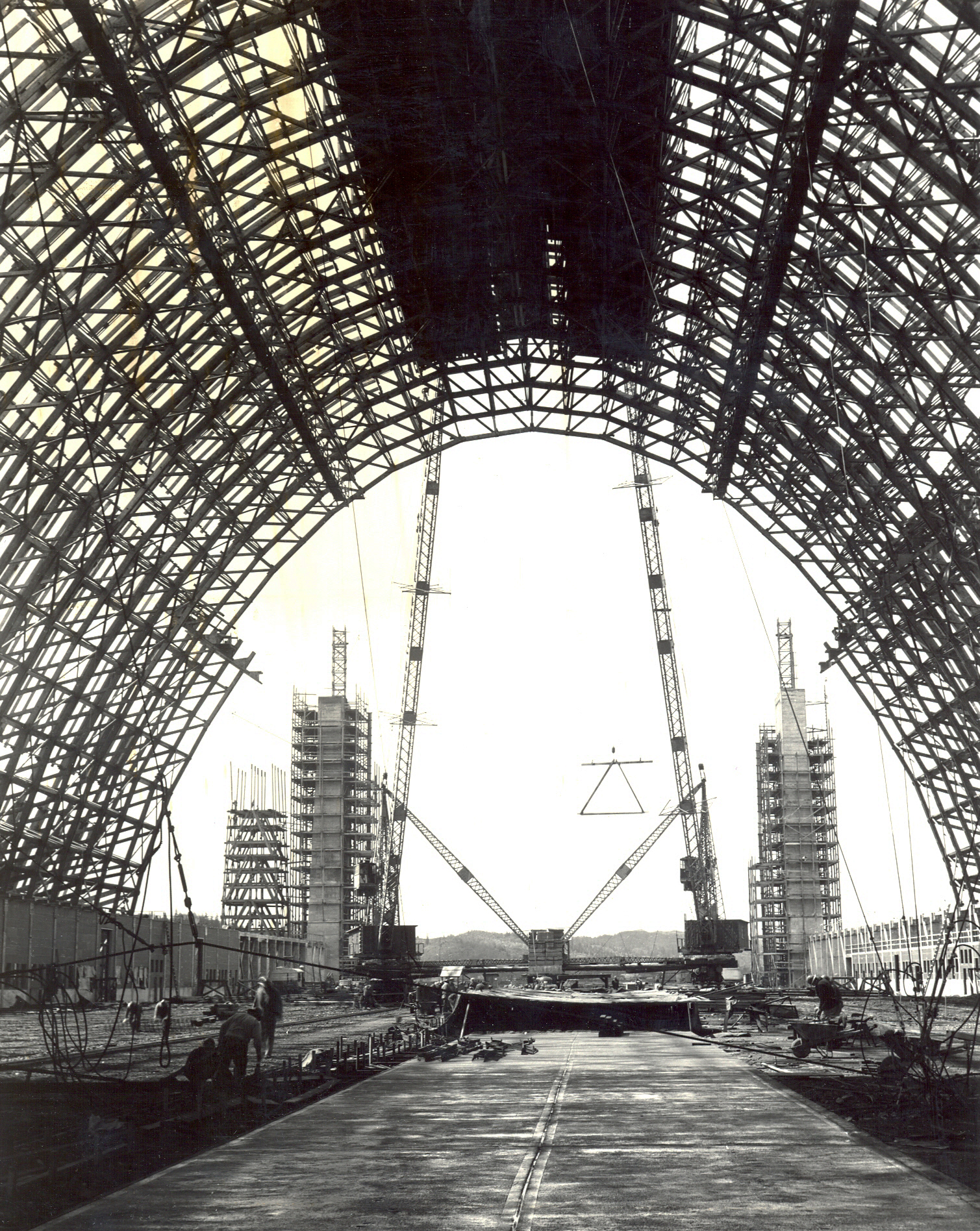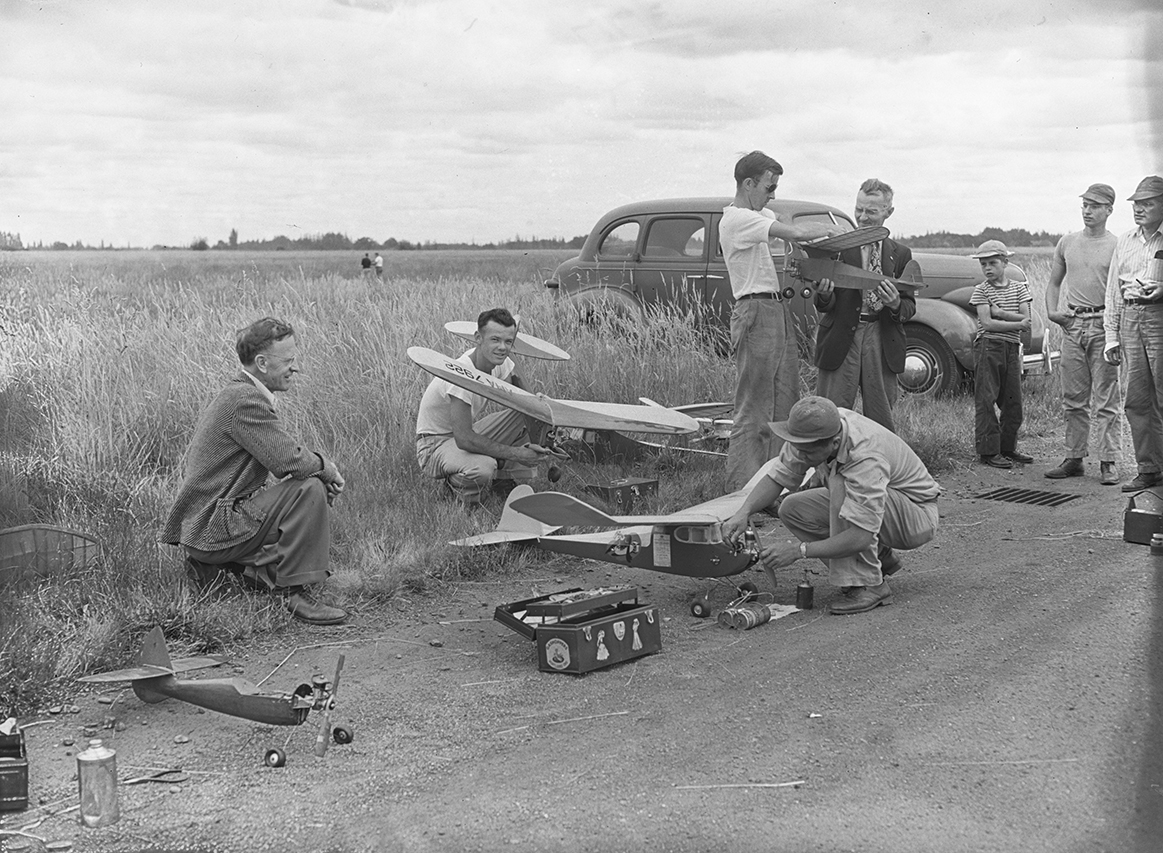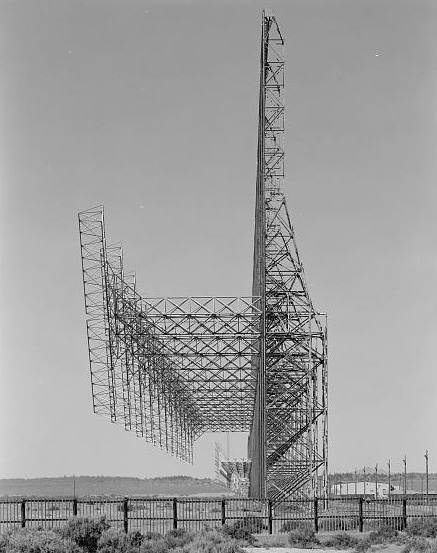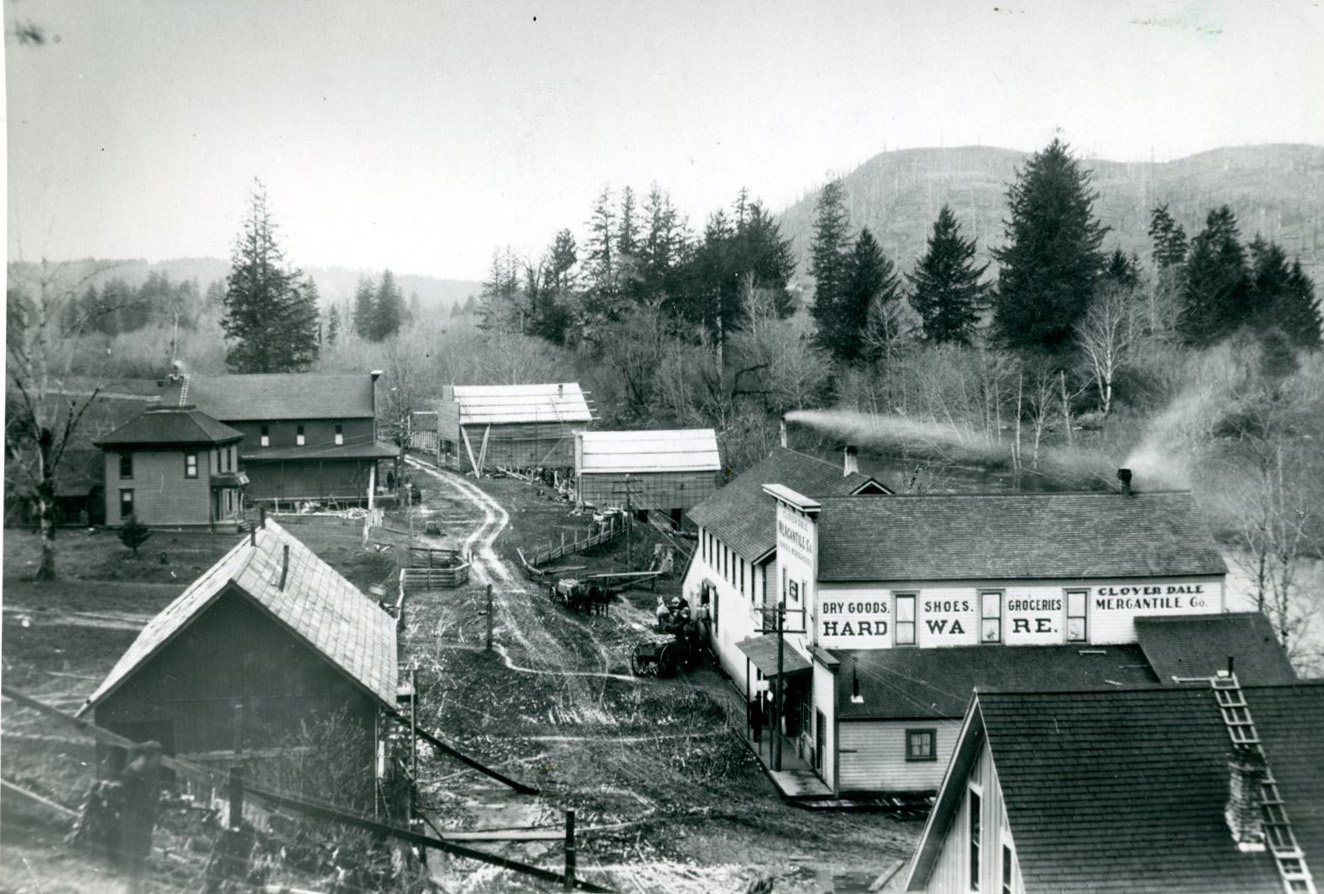Tillamook is home to the largest free-standing, clear-span wooden structure in the world. Covering more than seven acres, the building is 1,072 feet long, 296 feet wide, and towers more than 15 stories high. The air base, located about three miles south of the city, was ideal for blimp operation, with the surrounding hills providing a naturally sheltered location.
Hangar B of Naval Air Station (NAS) Tillamook was commissioned and constructed by the U.S. Navy in 1943 to house blimps for anti-submarine patrol and convoy escort. Hangar A, built in the same year in just twenty-seven days, was destroyed by fire in 1992. Together, the two hangars could house eight K-class blimps—each 252 feet long. (For comparison, the average Goodyear blimp is 190 feet long.) The gas envelope contained 425,000 cubic feet of helium and had a lift capacity of 7,700 pounds.
The buildings are worthy of note as much as the aircraft they accommodated. Each hangar required more than two million board feet of lumber, most of it from Oregon. Even the gutters and downspouts used wood to conserve metal, and more than 2,000 tons of steel were saved per hangar. Each timber was treated with fire retardant, and it took fifty different lumber companies to prepare and supply all the wood needed.
The buildings were completed in summer 1943. The first blimp had arrived on February 15 that year; but because there was no hangar to protect it, it was torn to pieces in a heavy storm on March 27.
With the huge hangars completed, NAS Tillamook stationed blimps during 1943-1945. They were used to watch over ports in Oregon and Washington and shipping lanes from California to the San Juan Islands, a 500-mile radius. These Lighter-than-Air (LTA) ships could stay aloft 48 hours, cruise at 50-67 knots, and cover 13,000 square miles of water during a day’s shift.
On September 15, 1945, two weeks after the Japanese surrender, Tillamook station was reduced to functional status. In October, the last two blimps left for California, and by mid-1946, all LTA wings were decommissioned by the U.S. Navy.
Three lumber companies in the Tillamook area—Rosenberg, Angel Lumber, and Diamond Lumber—had their operations in the hangars from 1949 to 1982. In 1984, Wren Aircraft leased Hangar A to build Cessna 182 Skylanes. But when fire destroyed Hanger A on August 22, 1992, it was used by Tillamook farmers and had 300 truckloads of hay in it.
After years of other uses, Hangar B has returned to much of its erstwhile glory. In 1992, the Port of Tillamook Bay established a small blimp museum and by 1996 displayed one of the finest collections of operational vintage World War I and II aircraft on loan from Jack Erickson, the founder of Erickson Air-Crane. By 2014, these aircraft were moved to the Erickson Aircraft Collection in Madras, but the Tillamook museum continues to operate as a historical site showing flight-related exhibits, including pieces of the German airship, the Hindenburg, a Luftwaffe flight jacket, a Japanese winter flight suit, and even a homing pigeon loft for birds that carried messages from airships back to the base.
A recent addition is the “Hall of WW II, “a presentation showing European battle scenes (Siege of Leningrad, the Battle of Remagen, Normandy, and the Battle of the Bulge), Pearl Harbor, the battles of Iwo Jima and the Philippines with the Imperial Japanese Navy, and Doolittle’s Air Raid of Tokyo, a retaliatory raid four months after Pearl Harbor.
Approximately 50,000 people a year visit the museum. Visitors can climb into a jet simulator and view historical wartime and aviation artifacts, as well as a display of tractors used in farming and by the U.S. Air Force. The museum offers guided tours for school groups.
-
![Airplane flying through open hangar bay at Naval Air Station Tillamook.]()
NAS Tillamook, airplane flying through.
Airplane flying through open hangar bay at Naval Air Station Tillamook. Tillamook County Pioneer Museum
-
![Local dignitaries greet Senator John F. Kennedy at Naval Air Station Tillamook, during Kenndy's presidential campaign, 1959.]()
NAS Tillamook, John F. Kennedy at.
Local dignitaries greet Senator John F. Kennedy at Naval Air Station Tillamook, during Kenndy's presidential campaign, 1959. Tillamook County Pioneer Museum
-
![Eight K-class airships of Squadron ZP-33 in hangar at Naval Air Station Tillamook.]()
NAS Tillamook, blimps inside hangar.
Eight K-class airships of Squadron ZP-33 in hangar at Naval Air Station Tillamook. Tillamook County Pioneer Museum
-
![Naval Air Station Tillamook during construction, 1942-1943.]()
NAS Tillamook, hangar construction 1.
Naval Air Station Tillamook during construction, 1942-1943. Tillamook County Pioneer Museum
-
![Naval Air Station Tillamook during construction, 1942-1943.]()
NAS Tillamook, hangar construction, B_5-6-1943.
Naval Air Station Tillamook during construction, 1942-1943. Tillamook County Pioneer Museum, B_5-6-1943
-
![Naval Air Station Tillamook during construction, 1942-1943.]()
NAS Tillamook, hangar construction 2.
Naval Air Station Tillamook during construction, 1942-1943. Tillamook County Pioneer Museum
-
![WW II D-Day Invasion on June 6, 1944, of the German-occupied France in Normandy. Gold Beach was one of five landing zones for the Allies, primarily targeted by British troops.]()
Photo of WWII D-Day Invasion in the Hall of WWII exhibit, 2025.
WW II D-Day Invasion on June 6, 1944, of the German-occupied France in Normandy. Gold Beach was one of five landing zones for the Allies, primarily targeted by British troops. Courtesy Ulrich H. Hardt
-
![Utah Beach was one of five sectors of the Allied invasion, where 1,700 vehicles and more than 21,000 American soldiers landed, with only minimal casualties on June 6, 1944.]()
Photo of Utah Beach display in the Hall of WWII exhibit, 2025.
Utah Beach was one of five sectors of the Allied invasion, where 1,700 vehicles and more than 21,000 American soldiers landed, with only minimal casualties on June 6, 1944. Courtesy Ulrich H. Hardt
-
![The WW II Pacific War Exhibit shows Japan's initial conquests and later Allied push back, ending in Japan's surrender. Key events include Pearl Harbor, the Battle of Midway, and the use of atomic bombs.]()
Photo of WWII Pacific exhibit in the Hall of WWII exhibit, 2025.
The WW II Pacific War Exhibit shows Japan's initial conquests and later Allied push back, ending in Japan's surrender. Key events include Pearl Harbor, the Battle of Midway, and the use of atomic bombs. Courtesy Ulrich H. Hardt
-
![First newspaper report of the attacks on Pearl Harbor and Manila.]()
Photo of Honolulu Bulletin--Extra in the Hall of WWII exhibit, 2025.
First newspaper report of the attacks on Pearl Harbor and Manila. Courtesy Ulrich H. Hardt
-
![WWII blimp landing on USS Carrier Yorktown off Oregon Coast]()
Photo of Hall of WWII exhibit, 2025.
WWII blimp landing on USS Carrier Yorktown off Oregon Coast Courtesy Ulrich H. Hardt
-
![Women joined the military branches by the thousands, serving as officers, drivers, cooks, parachute riggers, mechanics, factory workers, and in clerical positions, freeing men for combat.]()
Photo of Women in WWII exhibit, 2025.
Women joined the military branches by the thousands, serving as officers, drivers, cooks, parachute riggers, mechanics, factory workers, and in clerical positions, freeing men for combat. Courtesy Ulrich H. Hardt
-
![WWII Battle of the Bulge, also known as the Ardennes Offensive, was fought December 16, 1944, to January 25, 1945, in the Forest of Belgium and Luxembourg.]()
Photo of WWII exhibit, Battle of the Bulge, 2025.
WWII Battle of the Bulge, also known as the Ardennes Offensive, was fought December 16, 1944, to January 25, 1945, in the Forest of Belgium and Luxembourg. Courtesy Ulrich H. Hardt
Related Entries
-
![AJ Model Airplanes & Jim Walker]()
AJ Model Airplanes & Jim Walker
When Nevilles E. "Jim" Walker, the founder of the American Junior Aircr…
-
![Christmas Valley Air Force Station]()
Christmas Valley Air Force Station
The Christmas Valley Air Force Station, established in the late Cold Wa…
-
![Evergreen Aviation and Space Museum]()
Evergreen Aviation and Space Museum
The Evergreen Aviation & Space Museum and Captain Michael King Smith Ed…
-
![Tillamook]()
Tillamook
Tillamook, the county seat of Tillamook County and its largest city, is…
Related Historical Records
Map This on the Oregon History WayFinder
The Oregon History Wayfinder is an interactive map that identifies significant places, people, and events in Oregon history.
Further Reading
Manske, Kenneth A., ed. The History of Naval Air Station Tillamook and Its Role in World War II. Gresham, Ore.: M & A Tour Book, 1995.
The Tillamook Air Museum. http://www.tillamookair.com.

